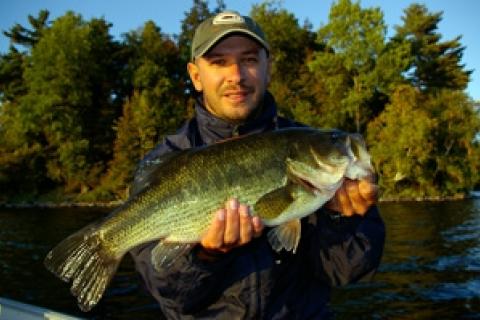
 A flat is an expansive lake area that is uniform in depth and structural makeup. For the most part, flats are relatively shallow (between 3 and 10 feet deep) and can be found both close to shore and mid-lake. They can be less than an acre in size to a mile or more in length. Bottom composition will remain relatively level, while aquatic plants found throughout it can vary from sparse to dense. To be honest, flats lack overall unique qualities, but this is what makes them gold mines for savvy bass prospectors.
A flat is an expansive lake area that is uniform in depth and structural makeup. For the most part, flats are relatively shallow (between 3 and 10 feet deep) and can be found both close to shore and mid-lake. They can be less than an acre in size to a mile or more in length. Bottom composition will remain relatively level, while aquatic plants found throughout it can vary from sparse to dense. To be honest, flats lack overall unique qualities, but this is what makes them gold mines for savvy bass prospectors.
The Perfect Flat?
Largemouth bass use flats for a number of reasons, but food ranks high. An expanse of water littered with weed and other structure makes an excellent feeding ground. Weed cover offers hiding spots for baitfish, giving ambushing largemouth ample opportunities to chow down.
A healthy mixture of vegetation, including cabbage milfoil and grasses, is a prerequisite. Not only should there be variety, but irregular patches, clumps and weedlines strewn throughout.
With close access to deeper water, largemouth move up on a flat at will and have the option to retreat to safety again, if the need arises. This is an important factor, as these fish seldom spend all of their time in skinny water.
When to Fish Flats
Early morning and evening - these are prime times to fish flats, with largemouth at the peak of activity. Light levels are low and fish won't be as apt to use cover to conceal themselves. Bass move throughout a flat at these times, generally scattered, yet covering water aggressively while chasing prey.
Use fast-moving presentations that cover water quickly and efficiently. Primarily, this means horizontal baits, with the nod given to spinnerbaits, jerkbaits, and topwaters, such as buzzbaits.
If You Go Mid-Day...
This period can offer the flats angler two distinct varieties of weather conditions. The first would be inclement conditions, such as strong winds, rain, cloud or a combination of some or all of these. Under these situations, largemouth will still be aggressive and searching for food away from cover. Hit the area with baits discussed above.
When the sun is high and winds are calm, though, change tactics. Bass become inactive or neutral, preferring to sit tight to cover and retreat into the dark recesses of vegetation. Slow down and rely on a vertical presentation. Search for the thickest and greenest weedbeds and clumps.
A flipping stick and stout line become your best friends on the flat, allowing you to flip and pitch accurately, while also providing the muscle to horse fish out and away from the green stuff.
Baits to throw run the gamut from flipping jigs, Texas-rigged worms, lizards, craws and tubes. Most soft plastic baits will do, as long as they're weedless.
Pick apart a flat this season. It may just cough up that lunker you've been looking for.
- 6211 views

